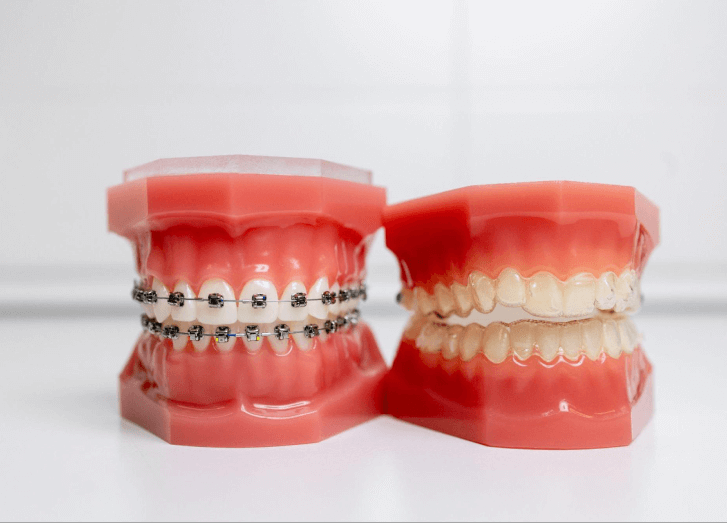What factors does our orthodontist at Alliston Orthodontics & Oral Surgery recommend for patients to consider when deciding between Invisalign or braces? Here are some insights on how we assist with this important decision.
Invisalign vs. Braces
When it comes to orthodontic treatment, you may be faced with the decision of choosing between braces or Invisalign clear aligners. It’s important to consider your individual needs and circumstances when making this choice. At our practice, our orthodontists consider several factors when recommending treatment options to our patients. We’re here to help answer any questions you may have and guide you toward the treatment that is most suitable for you.
Braces have traditionally been made of metal and attached to the front of the teeth. However, with advances in technology and treatment methods, there are now various options available, including translucent (ceramic) braces and coloured braces. These devices use rubber bands and metal wires to move the teeth into their proper positions and address orthodontic issues.
Invisalign features clear, custom-made plastic aligners that gradually shift the teeth into their correct positions. An orthodontist will take a 3D scan of the mouth to ensure proper measurements and create aligners that fit your teeth precisely.
Can you choose between Braces & Invisalign?
The choice between braces and Invisalign will depend on the specific orthodontic issues identified by your orthodontist during your initial assessment. Invisalign may not always be the best option for patients with more severe orthodontic problems, so it is important to get personalized advice from your orthodontist based on your specific circumstances. In this post, we will explore some of the reasons why people may choose either Invisalign or braces, as well as the potential drawbacks of each, to help you make an informed decision.
Is Invisalign better than braces?
As you consider your options, you may be wondering which is the better choice for you. It’s important to keep in mind that what works for one person may not be the best fit for another, as the decision can depend on your circumstances and needs. To determine the right treatment for you, it’s important to consider the pros and cons of Invisalign versus braces, how they align or differ with your orthodontic needs, and concerns about treatment duration, appearance, and more. Your orthodontist can help you weigh these factors and make an informed decision.
Advantages of Invisalign
You can take your clear aligners out to eat, drink and play sports.
If you’re considering Invisalign, you may be wondering how often you’ll need to wear the aligners. It’s important to wear clear aligners for 22 hours per day to achieve the best results. However, you can still enjoy meals and certain activities by removing the aligners for 2 hours each day. This means you can continue to eat your favourite foods, drink beverages other than water (you should remove the aligners to drink anything other than water), and participate in sports or play musical instruments without worrying about damaging the aligners. This flexibility is not possible with braces, which are fixed in place and may require adjustments to your diet.
Clear aligners are transparent.
One of the benefits of Invisalign is that they are nearly invisible, which makes them a popular choice for patients who are self-conscious about their appearance. With Invisalign, you can go about your daily life without worrying about metal brackets and wires standing out on your teeth. This can be especially appealing for teenagers and adults who are concerned about how braces will affect their appearance in social and work situations.
You’ll be able to continue brushing and flossing normally.
One advantage of Invisalign clear aligners is that they do not require the same level of maintenance as braces. You won’t need to worry about navigating around metal wires and brackets while brushing and flossing. Instead, you can simply soak your aligners in a cleaning solution (never brush them, as this can cause scratches or damage) and continue your normal brushing and flossing routine, making sure to remove all food particles and debris that can lead to plaque. It’s important to maintain good oral hygiene no matter which orthodontic treatment you choose, as it will be key to your success throughout the process.
You might spend less time in your orthodontist’s chair overall.
Many patients are concerned about the comfort of different orthodontic treatment options, and may be wondering which is more painful: braces or Invisalign? It’s important to note that you may experience some pain or discomfort with either option. However, because Invisalign does not use metal brackets and wires, you may have a lower risk of experiencing scratched or sensitive cheeks due to wire irritation. This can be a factor to consider when deciding which treatment is best for you.
Disadvantages of Invisalign
There are a few potential disadvantages to Invisalign that patients may want to consider depending on their lifestyle, self-discipline, and budget. Some specific factors to keep in mind include:
You’ll need to consider Invisalign’s effectiveness vs. braces to treat your problem.
In some cases, we may not recommend Invisalign for patients, particularly if they have more complex orthodontic issues. If you are trying to decide between Invisalign and another treatment method, it’s important to ask your orthodontist if you can expect similar results from either option. This will help you make an informed decision about which type of orthodontic treatment is best for you.
You’ll need to be disciplined.
Compliance with your treatment plan is crucial for success with any orthodontic treatment. One important aspect to keep in mind with Invisalign is that it is essential to wear clear aligners for 22 hours per day. This means that you need to track the time that the aligners are out of your mouth for any reason, such as brushing, flossing, eating, or participating in sports. If you do not consistently wear the aligners as prescribed, you may not achieve the intended results within the specified period of your treatment plan, and your plan may need to be revised. Remember to put the aligners back in after each activity
It can be inconvenient to remove and place your clear aligners back in your mouth.
If you eat or drink frequently in public or travel often, you may find it difficult to remove your Invisalign aligners discreetly without losing them. However, it’s important to remember that the aligners must be removed before eating or drinking anything other than water. You should also brush your teeth before replacing the aligners, as food particles can build up and affect the movement of your teeth according to your orthodontic treatment plan. If you don’t maintain good oral hygiene, your aligners may become stained and you may be at higher risk for cavities and bad breath.
If you choose Invisalign, it can be helpful to carry a carrying case to keep your aligners clean and protected when they are not in use. This can help to prevent damage and keep them in good condition.
You’ll need to take costs and finances into account.
The cost of Invisalign clear aligners may be similar to or slightly higher than the cost of braces, depending on the nature of the orthodontic issue being treated, the duration of treatment, and other factors. In some cases, certain orthodontic problems may be difficult or impossible to address solely with Invisalign, and the orthodontist may recommend using braces to finalize tooth positions. This could potentially increase the overall cost of your treatment.
You may need attachments.
In some cases, attachments may be required to help the Invisalign aligners stay in place and move the teeth as prescribed. These attachments are small, button-like pieces that mimic the color of teeth and are placed on certain teeth. The number of attachments needed can vary from patient to patient, with some not needing any and others requiring them on most teeth. While these attachments are designed to blend in with the teeth, they may give the appearance of wearing clear braces rather than clear aligners.
Advantages of Braces
They are a versatile treatment option.
Braces are a powerful orthodontic treatment option that can correct both simple and complex facial and dental issues, helping you achieve your desired smile. Braces use brackets, anchors, and wires to move the teeth into their proper positions, making them effective for precise results and potentially shorter treatment times. Your orthodontist may recommend braces if they are necessary to achieve the desired results and can apply more force to move the teeth into proper alignment. Invisalign may have limitations on how much teeth can be shifted, so braces may be a better option in certain cases..
You’ll have multiple types of braces to choose from.
If you want to make your braces less visible, we offer ceramic (translucent) braces that are made of tooth-coloured ceramic material instead of metallic grey or silver. This allows them to blend in with your teeth, making them less noticeable. If appearance is a concern for you, we may have a solution even if you do need braces
The duration of your treatment may be shorter with braces.
If your goal is to correct misalignment and close gaps between teeth, the treatment time for some patients may be shorter with braces compared to Invisalign. If you are looking to complete your orthodontic treatment as quickly as possible, it may be helpful to ask your orthodontist if one treatment option will significantly reduce the duration of your treatment. This can be an important factor to consider when making your decision.
Disadvantages of Braces
You may be less than enthusiastic about the appearance of braces.
Some people may feel self-conscious about their appearance when wearing traditional metal braces, as they can be more noticeable on the teeth. This may be a concern in social or work settings. If appearance is an important factor for you, it may be helpful to discuss your options with your orthodontist
You may find brushing your teeth challenging.
Brushing and flossing with braces may require a bit more effort, as the braces are fixed in place (unlike Invisalign aligners, which can be removed). You’ll need to be careful when brushing around the brackets and wires. If your teeth are not cleaned properly while you are wearing braces, plaque can accumulate around the braces, leading to tooth decay and staining that may remain even after the braces are removed. That’s why our orthodontists take the time to teach patients how to effectively brush and floss with braces.
You’ll need to take extra care choosing food.
When wearing braces, it is important to avoid hard and sticky foods that can damage the braces or cause food to get stuck in the wires. You should also avoid carbonated or acidic beverages, as they can lead to tooth decay and harm your braces. If any food gets stuck in the archwire, breaks a bracket, or causes a bracket to come loose, you will need to visit your orthodontist right away to have the issue repaired. Multiple incidents with braces can prolong treatment time.
You’ll need to see your orthodontist for regular visits.
After you get braces, you’ll need to visit your orthodontist approximately every 4-6 weeks to have them adjusted, check your treatment progress, and determine if any changes need to be made to stay on track with your treatment. With Invisalign, you’ll have fewer visits to the orthodontist, typically about every 8 weeks or so, as the aligners have already been made and you’ll change them at home.
How will I make the right decisions about my orthodontic treatment?
If you are just beginning to explore your orthodontic treatment options, you may be feeling overwhelmed or confused as you try to determine which option is best for you. There are many factors to consider, and it can be a lot to think about. However, you don’t have to go through this process alone. Our team is here to answer your questions and address your concerns every step of the way. We’ll provide recommendations to help you make informed decisions about your oral health.
Are you trying to decide between braces and Invisalign clear aligners for your orthodontic treatment? Contact us at Alliston Orthodontics & Oral Surgery to schedule an appointment for an initial assessment. We can help you understand your options and make an informed decision.










